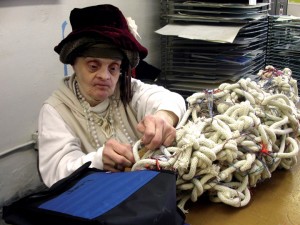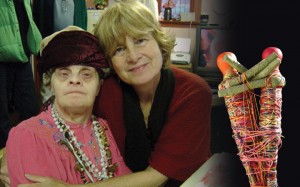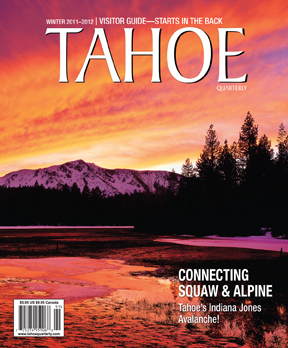Featured: Judith Scott
Inside the life and works of Judith Scott
Author Trina Kleist penned for us, along with our main arts feature in the Summer Tahoe Quarterly, a number of sidebars to better explain Judith Scott’s amazing story. Please take the time to peruse them:
-What constitutes “outsider” art?
-From Dutch Flat to Berkeley and Bali
The enigmatic fiber artwork of a once-discarded woman
Written by Trina Kleist
Frogs croak, birds warble and trains blare past Dutch Flat, a former Sierra Nevada gold mining town. A spring rain douses creamy pear blossoms, daffodils, manzanita and cypress. The air smells of damp earth and pine and wood smoke.
Part-time resident Joyce Scott often escaped to this historic area, just west of Tahoe on I-80, with her twin sister, fiber artist Judith Scott, on weekends from their Berkeley homes. In this realm of picket fences, rusting water cannons, retirement homes and Baptist hymns, Judith died in 2005; she left more than 200 unique sculptures, crafted over 18 years, at Creative Growth Art Center in Oakland.
Judith Scott’s work seems strange to some, sublime to others. Her bundles of sticks and found objects, wrapped and sewn and knotted over with yarn, string and strips of fabric, have been likened to cocoons, wombs, human figures and landscapes. Pregnant with mystery, they have been embraced by a movement challenging conventional definitions of who can create art.
“So many people have written to me that they’ve gone into a room with Judy’s work and have gotten chills all over their body,” says Joyce. “There is a sacred quality to her work.”
A Shattered Childhood
The Scotts’ story adds a compelling layer: The fraternal twins were born in 1943, the youngest of five siblings. Judith had Down syndrome, was rendered deaf in infancy by scarlet fever and developed no verbal language. Yet, Judith lived a sensually rich and largely happy life at the family home near Cincinnati, Ohio, until age 7, when medical and pastoral advice pushed her parents to send her to a state institution in Columbus. There, she lived in deprivation for 36 years. Joyce rescued her twin in 1986 at age 43, brought Judith to her home in California and, in 1987, enrolled her in Creative Growth, a center for disabled adults.
A year after her release from the institution, Judith found a medium of expression. She worked intently five hours a day, five days a week on her pieces, which were first exhibited in 1991. In October 2011, a rare, one-woman exhibition at London’s Museum of Everything launched Scott to worldwide acclaim, lifting her “as a symbol for all artists with differences,” says museum founder James Brett.
Regardless of disability, her creations show “startling complexity and originality,” says Matthew Higgs, director of White Columns Gallery in New York, of the 2011 exhibit. He adds that they “constitute one of the most important bodies of work… produced anywhere and under any circumstances in the last 20 years.”
German artist Rosemarie Trockel included Judith’s work—which she considers “exemplary and inspiring”—with an exhibit of her own creations that in April concluded a tour of Madrid, New York and London.
Critics called Judith Scott “preternaturally gifted” and “a genius.” Her works sell for as much as $20,000 and are in permanent collections around the world, including at the Museum of Modern Art in San Francisco and the groundbreaking Collection de l’Art Brut in Lausanne, Switzerland.
‘Matriarch’ of the Art Studio
Promptly at 9:30 a.m. on weekdays, Judith Scott would get off a bus and breeze through the glass doors of Creative Growth Art Center in Oakland’s gentrifying automotive district. She adorned her head with colorful scarves, wigs or hats, and sported bracelets, small pins and long strings of beads.
Carrying a load of fashion magazines under one arm, the tiny woman would walk to the back of the spacious, sunny studio, put her things on a rack, drink from a nearby fountain and set to work, recalls projects manager Jennifer O’Neal. At 3:45 p.m., Judith would place her unfinished creation under the table, as if hiding it, and prepare to leave.
Judith had an unmistakable presence. “She had a whole table to herself,” O’Neal says. “She was the matriarch. She knew what she wanted.
“And,” O’Neal adds, “she was bossy.” When visitors surpassed her patience, Judith shooed them away.
In 1974, Florence and Elias Katz founded Creative Growth, the world’s first and still-largest art center for disabled adults. In this milieu, Judith arrived in spring 1987 and spent about six months trying different media, showing little interest, writes John M. MacGregor in his 1999 book, Metamorphosis: The Fiber Art of Judith Scott. Later that year, Judith began attending a class taught by fiber artist Sylvia Seventy. Judith was indifferent to the representational needlepoint the other students produced. But she found something else.
“I had a box of (willow) sticks in the classroom,” Seventy tells MacGregor. “She started stealing these sticks and wrapping them” with yarn and fabric.
The shift was so remarkable that staff photographed Judith in the process. “Those pieces were Judith’s first words,” says center director Tom DiMaria. “She found a capacity to communicate… in a nonverbal way.”
It also marked an artistic breakthrough. “Judith’s first three-dimensional piece… conforms to no known genre or object,” writes MacGregor, an artist and psychiatrist.
Judith worked obsessively, choosing color, texture and shape largely independent of outside influences, adds DiMaria.
Buried in Judith’s works are electric fans, shopping carts, keys, lampshade frames, tree branches, beads, brooms, blocks of wood—items she would choose and sometimes steal from materials in the studio. She wound and knotted around the items repeatedly. When she finished, after weeks or months, she gestured with her hands, indicating she wanted the work taken upstairs to a storeroom, then she would start on the next one, O’Neal says.
“There was no one directing her,” DiMaria says. “We couldn’t if we wanted to.”
Landscape of a Life
Upstairs, DiMaria lifts a weighty oval of wool yarn and raffia in sheep white and Wedgewood blue. The bundle is largely smooth and regular, except for the quarter-inch wire and the wooden handle of an enameled iron saucepot poking out. A cardboard yarn spool can be felt beneath the layers. The bundle smells of lanolin and cotton.
Other bits of contrasting color can be seen in the fibers wrapped, sewn and pulled taught against each other: Bright purple under earthy green; a strip of denim wound taut over the handle; bits of orange and brown selvage peeking from beneath sky-blue thread.
“Here, you see a splash of red as the final accent color,” DiMaria says, pointing. “These are not arbitrary decisions. To use one color and then stop, that’s an artistic decision.”
Joyce Scott and others see a range of experiences from Judith’s life expressed in her work: The natural and family world she inhabited until age 7; the loss, grief and sorrow upon being torn away; the insecurity in one’s possessions at the institution; and the unique sense among twins of being both two and one at the same time. The sensation of running natural fibers through her hands in a repetitive motion may have related to pleasant childhood memories of running her hands through the grass and playing in the sand, Joyce speculated in a 2011 interview with Brett.
“In some of her work, I can see the landscape of our childhood—the sensuality and the texture,” Joyce Scott says. “We both grew up so intricately enmeshed in nature and in each other.”
For more than a century, the mainstream art world has considered the works of self-taught and self-inspired creators beyond real “art.” The distinction comes in the intention of the creator, writes the Museum of Everything’s Brett (read more about “outsider” versus “insider” art at www.tahoequarterly.com). Yet, a 60-year-old movement has gained steam in the last decade to disregard intention, focusing instead on process and product.
“What makes Judith’s work so fascinating is that her creativity is just like all our creativity. We are the same in this regard,” says Brett. “We were created. We create.”
That Judith Scott’s art continues to draw acclaim strikes Joyce as “astounding. It’s the last thing I expected.”
And it gives her hope.
“It speaks for the potential within every human being,” Joyce says. “Great beauty and great giftedness can be found in anyone.”
All they need, she says, is the chance to express themselves.
Freelance writer Trina Kleist lives in Grass Valley, California, and can be reached at tkleistwrites@gmail.com or (530) 575-6132.
Category: Arts & Culture, Personalities








